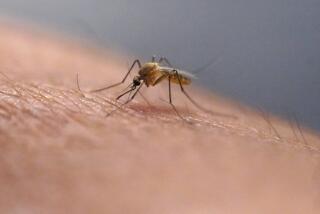Dengue Outbreaks at Tourist Sites
- Share via
Outbreaks of dengue fever, a potentially fatal viral disease spread by the bite of an infected mosquito, are striking some popular tourist destinations this year, prompting public health officials to step up eradication efforts.
Most tourists engaged in typical activities are at little risk of catching dengue fever, health officials said, but are encouraged to educate themselves about the disease and to take precautions.
Dengue fever is at epidemic proportions in Puerto Rico. As of last week 8,000 cases had been reported and six deaths from dengue confirmed there so far this year, said Gary Clark, chief of the Centers for Disease Control dengue fever branch in San Juan.
“Dengue is with us all the time,” Clark said. But the number of cases so far this year in Puerto Rico is “about four or five times” above normal.
In Mexico, there have been about 2,380 reported cases of dengue fever so far this year, according to Dr. Jorge Ricardez, assistant director of vector control, compared with 5,805 cases in all of 1997.
Dengue fever also occurs in the Pacific islands, the Caribbean, Central and South America, Africa and most of tropical Asia.
In Puerto Rico, the CDC is working closely with hotels and other tourism operators to emphasize the need to eliminate standing water, an ideal breeding ground for the Aedes aegypti mosquito responsible for dengue fever, Clark said. Public service announcements in movie theaters and on television alert viewers to the dangers.
Hotel officials said they are stepping up their mosquito abatement programs. “We are spraying insecticides on our premises a little more than usual,” said Sigrid Velez, a spokeswoman for the Hyatt Resorts in Puerto Rico, which operates two hotels on the north coast.
“We are taking a look at the issue,” said Jennifer de la Cruz, spokeswoman for Carnival Cruise Lines, which docks in San Juan and allows passengers to disembark.
Clark advised that travelers destined for areas known to have dengue fever take along a bottle of insect repellent with 20% to 30% DEET (N1N-diethyl-m-toluamide) and to apply it if they notice mosquitoes. Travelers staying in bedrooms with unscreened windows and without air-conditioning should use mosquito netting over the beds. For extra protection, the netting can be sprayed with the insecticide permethrin.
Most travelers staying at hotels are at minimal risk, Clark said, because the Aedes aegypti mosquito is most often found in urban residential areas rather than at hotels and resorts, where maintenance teams are more likely than homeowners to eliminate containers of standing water.
People traveling to Puerto Rico to engage in typical tourist activities such as visiting the beach, snorkeling or sightseeing in the rain forest, Clark said, are at very low risk of contracting dengue fever. Few mosquitoes are found near the beach.
Even so, all travelers should know about the symptoms of dengue fever. The bite itself can go unnoticed, and symptoms often don’t occur until a week later. These can include a high fever, joint pain, severe headache, pain behind the eyes and a rash on the trunk. If any of these symptoms develops after a trip to a dengue fever-endemic area, travelers should seek medical attention, Clark said.
The milder form of dengue fever usually passes with only treatment of symptoms. Drinking fluids, resting and taking acetaminophen to reduce fever are advised. A rarer, more severe form of the disease, called dengue hemorrhagic fever, involves blood vessel damage and can be fatal. In the beginning, the symptoms are the same as those of dengue fever, but they soon progress to faintness, shock and generalized bleeding, according to the CDC.
There is as yet no vaccine for dengue fever, although researchers are making progress. Last year University of Michigan researchers announced they had discovered how the dengue fever virus attaches itself to cells.
Healthy Traveler appears twice a month.
More to Read
Sign up for The Wild
We’ll help you find the best places to hike, bike and run, as well as the perfect silent spots for meditation and yoga.
You may occasionally receive promotional content from the Los Angeles Times.





